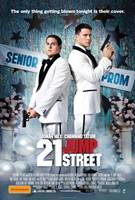Josh Brolin Hail, Caesar!
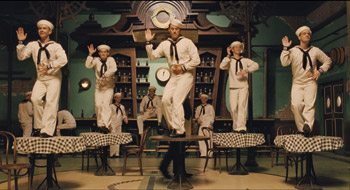
Josh Brolin Hail, Caesar!
Cast: Dolph Lundgren, Josh Brolin, Scarlett Johansson, Jonah Hill, Tilda Swinton, Channing Tatum, George Clooney, Ralph Fiennes
Directors: Ethan Coen, Joel Coen
Genre: Comedy, Musical
Rated: PG
Running Time: 106 minutes
Synopsis: When the world's biggest star vanishes and his captors demand an enormous ransom for his safe return, it will take the power of Hollywood's biggest names to solve the mystery of his disappearance. Bringing the audience along for a comic whodunit that pulls back the curtain and showcases the unexpected humor and industry drama found behind the scenes, Hail, Caesar! marks the Coens at their most inventive.
Eddie Mannix's (Brolin) job as a studio fixer begins before dawn, as he arrives just ahead of the police to keep one of Capitol Pictures' prized starlets from being arrested on a morals charge. His work is never dull, and it is around the clock.
Each film on the studio's slate comes complete with its own headache, and Mannix is tasked with finding a solution to every one of them. He is the point man when it comes to procuring sign-off from religious leaders on an upcoming Biblical epic…as well as when disgruntled director Laurence Laurentz (Fiennes) shirks at having cowboy star Hobie Doyle (Ehrenreich) thrust upon him to appear in Capitol's latest sophisticated drama.
While he rushes from one star's-self-induced emergency to another, not only must Mannix figure out a press-friendly way for swimming sensation DeeAnna Moran (Johansson) to work her way out of a personal jam, he must make sense out of the latest suspicious behavior of song-and-dance superstar Burt Gurney (Channing Tatum).
As if these giant-ego dramas weren't enough with which to start the day, Mannix has been confronted with the biggest crisis of his career: one of the studio's biggest moneymakers, Baird Whitlock (George Clooney), has been kidnapped right in the middle of production of his latest swords-and-sandals epic, Hail, Caesar!, and a mysterious group that calls itself 'The Future" has claimed responsibility. Either the studio forks over $100,000, or they can say goodbye to their bread and butter.
Zipping from one problem to the next, Mannix must keep the lid on all of them, all the while horse-trading information to keep his talents' names out of the gossip columns written by a pair of rival siblings, Thora and Thessaly Thacker (Tilda Swinton). Well, at least their names out of concocted stories he isn't interesting in promoting to the sisters' readers.
For this fixer, it's all in a day's work.
Hail, Caesar!
Release Date: February 25th, 2016
About The Production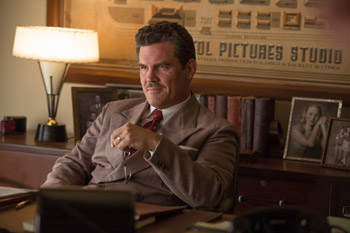
Welcome to Hollywood: Hail, Caesar! Begins
Hail, Caesar! is an homage to Hollywood's Golden Age, a valentine to the studio system laced with a lovingly acerbic edge. The film celebrates the dream factory, while cleverly pulling back the curtain to reveal some of the less-than-flattering inner workings of the film business in its heyday.
The comedy is set in the early 1950s, a period for the motion picture industry when its glamorous façade was beginning to show visible cracks. The major studios had recently been forced to divest themselves of their theaters and were facing the sudden growth of a new rival: television. They were also beset by changes in the post-World War II political and social landscape, including the hysteria of the Red Scare and the Cold War.
Hollywood responded to these threats, real and imagined, by providing audiences with big, splashy escapist entertainments: wide-screen Biblical epics featuring casts of thousands, bold Technicolor movie musicals and Busby Berkeley-style aquatic spectaculars, as well as a supply of Westerns and sophisticated drawing-room dramas.
The well-oiled machine was run like a fiefdom, with studio bosses exerting tight control over every aspect of their talents' professional and private lives. Careers were shaped and manicured. Stars were told what movies they could appear in, how to dress, and who to date. When, inevitably, some of the actors chafed or rebelled, studios employed a fixer to cover up indiscretions and keep them out of the public eye. No cost was too great to maintain the illusion of glamour.
'Today, we're so used to knowing every little thing about actors and celebrities and digging into the deep dark truths of their lives," observes Scarlett Johansson, who plays DeeAnna Moran, an aquatic film star loosely patterned on Esther Williams. 'Back then, the public wanted to believe that the stars were in fact as otherworldly and ideal as they were being projected. The studios did more to protect their -trophies' back in that system. The stars were like property, under contract forever and could be loaned out at any time. There were good things about that system and bad. On the one hand, they were taken care of, and on the other, it could be rather suffocating."
Back in the day, stars were protected by the likes of Eddie Mannix, the fixer for the fictitious Capitol Pictures. The character is a composite of the real Eddie Mannix and Howard Strickling, who performed the same function for MGM. Mannix, a former bouncer, spends his days putting out fires, from sexual peccadilloes to coaxing religious leaders to approve the latest Biblical spectacle. Explains Ethan Coen: 'His job would be to find some movie star down in San Diego drunk, and retrieve him and pay off all the people that he offended along the way, or get somebody who is secretly gay married off."
The idea for Hail, Caesar! originated more than a decade ago, according to George Clooney, the Oscar®-winning actor who appears as the vain and spoiled Baird Whitlock, the star of the Biblical epic Hail, Caesar!, which gives this film its name.
George Clooney was starring in another Coen brothers' project when the filmmakers approached him. 'At the time," George Clooney recalls, 'they asked if I wanted to play this actor who gets kidnapped. They had about three pages of plot written down and a few terrific lines. That's it. Of course, I said, -Yes.'"
Over the years, when journalists asked George Clooney about his upcoming projects, he'd inevitably mention Hail, Caesar!. 'It even showed up on IMDB," George Clooney laughs. 'But here's the thing. There was no script."
Joel Coen reaffirms the story: 'It's true. Finally, we got so much grief, that we decided to sit down and write the script. Besides, it was time. If we waited much longer, everyone we wanted for the film would be too old for their roles."
At the same time as they comically send up the more hypocritical aspects of the studio system, the Coen brothers showed great respect and admiration for the professionalism and craftsmanship that characterized Hollywood's Golden Age. Through the various movies being shot on the Capitol lot"and on location in and around Los Angeles"we follow the on- and off-screen lives of those whom Mannix protects.
For his part, Working Title's Eric Fellner was pleased to be back on board with the Coens. He reflects: 'Tim and I have been so fortunate to work with Joel and Ethan for so many years. This film is not only a culmination of their work, it's a reflection of their love of the industry. It's no surprise that so many of their favored performers have returned to be a part of it, and we so appreciate the obvious care for the material and unparalleled craftsmanship they've delivered."
Our Biggest Stars: Casting the Comedy
Reflecting the glitter of the star machine during the 1950s, the filmmakers have assembled a powerhouse of contemporary talents whose wattage is as bright as during Hollywood's heyday, starting with the central character of Eddie Mannix, the world-weary, overstressed studio fixer played by Josh Brolin.
'Eddie Mannix's on call 30 hours a day," states Josh Brolin. 'It never stops. But here's the thing: Despite the stress, he thrives on being the studio cop, on being a million places at once. What's the next problem? What's the next answer? He wants to keep busy. It's show business, but it's also business."
The secret to Eddie Mannix's success, Josh Brolin shares, is that, 'He is a great father figure. He's an incredible paternal force, so I like him in that way. In private, he's an incredibly insecure guy, but when you see him in public, on movie sets, when he's dealing with all sorts of debauched children, his whole motivation is loyalty to the studio and his boss, Nick Schenk, who gave him his start. He doesn't let anything slip through his fingers."
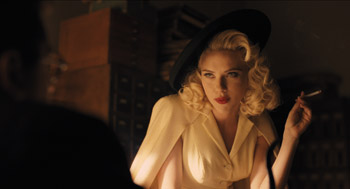 Like all good parents, Eddie Mannix 'knows when to be stern and when to be caring," Josh Brolin reveals. 'The actors know he's going to be there for them, that he will provide safety within the studio bubble. But if you go outside of the bubble, then you're disloyal and you're not working within the family. It's a Mafia mentality, which reflects Eddie's past as a nightclub bouncer."
Like all good parents, Eddie Mannix 'knows when to be stern and when to be caring," Josh Brolin reveals. 'The actors know he's going to be there for them, that he will provide safety within the studio bubble. But if you go outside of the bubble, then you're disloyal and you're not working within the family. It's a Mafia mentality, which reflects Eddie's past as a nightclub bouncer."
Throughout the comedy, Eddie Mannix often seems overwhelmed by the scandals he has to quash on a daily basis, but according to Josh Brolin, the fixer thrives on the stress. 'Some people like stress; they feed off it. They love the idea of problem solving, and you can't problem solve without a problem. So you're constantly looking for those to solve. That's the movie business in a nutshell. You have a ton of people who are looking for the stress. The irony is that they complain about it, but they wouldn't know how to live without it. That's Eddie Mannix to a tee."
One of Eddie Mannix's partners in crime is Capitol Studios' film editor, C.C. Calhoun, played by Oscar®-winning actress Frances McDormand, who runs a tight ship, she assures us, allowing anyone near her state-of-the-art Moviola strictly on an invitation-only basis. 'Actors are never allowed into the editing room," Frances McDormand advises. 'They get too self-conscious about their work."
The most trusted editor in the Capitol system, C.C., may be found hiding behind thick glasses and an even thicker layer of cigarette smoke. Known to work around the clock, she's ready to assist Eddie Mannix with what's going right (and often with what's going wrong) with a film in production.
But Eddie Mannix is always welcome and he and C.C. share many delicate secrets, though she's not telling any of them. 'I would never divulge that kind of information," says Frances McDormand, slipping into character. 'No sir-ee. I made a pledge when I started this job and, as we all know, loose lips sink ships."
Another crucial piece of casting was George Clooney who, in Hail, Caesar!, adds to his oeuvre of playing what he calls 'idiots" in Coen brothers movies, which he's done three previous times"in O Brother, Where Art Thou?, Intolerable Cruelty and Burn After Reading. But the character of Baird Whitlock, he says, 'is maybe the dumbest character I've played for them. He's just a clueless movie star, which of course could never happen in real life, now could it?" he grins.
The headliner of Capitol Pictures' upcoming Biblical tale, Hail, Caesar!, Baird Whitlock has had a long and illustrious career with the studio. Unlike some of Capitol's other stars, Baird Whitlock doesn't chafe at the restrictions of being under exclusive contract. George Clooney explains: 'He is used to being taken care of, and he's quite comfortable and feels protected in that world."
George Clooney echoes Josh Brolin's sentiment about Eddie Mannix being the ultimate father figure. 'He plays father to all the characters in the film," the performer says. 'Eddie Mannix's great burden is having all these unruly children who have lots of money and huge egos, but absolutely no sense of north and south. His job is to be their moral compass."
Rarely has Eddie Mannix had to work as much overtime with talent as he has with Baird Whitman; the man's philandering and carousing is unparalleled. When Baird Whitman is kidnapped and held for ransom by a mysterious group known as The Future, all hell is about to break loose.
In the midst of the disappearance, another problem Eddie Mannix has to fix is DeeAnna Moran, played by Scarlett Johansson, who starred in the Coen brothers' drama The Man Who Wasn't There at the age of 15. 'DeeAnna Moran is very professional, but due to an unfortunate event off the set, she's in a bit of a bind"both figuratively and literally"and she needs some help," says Scarlett Johansson. 'Eddie Mannix is charged with coming up with suggestions to maintain her façade of purity and innocence."
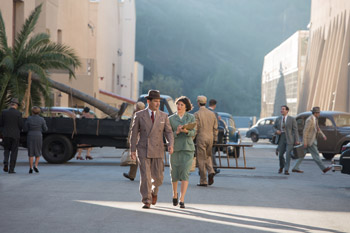 Currently shooting her latest underwater extravaganza, DeeAnna Moran has been a huge moneymaker for Capitol. Her beauty, brains and talent are only matched by her aquatic abilities and savvy navigating of murkier waters, and she'll do whatever it takes to remain the studio's No. 1 draw. In fact, Eddie Mannix comes up with a viable solution, which echoes a similar predicament faced by actress Loretta Young back in the day.
Currently shooting her latest underwater extravaganza, DeeAnna Moran has been a huge moneymaker for Capitol. Her beauty, brains and talent are only matched by her aquatic abilities and savvy navigating of murkier waters, and she'll do whatever it takes to remain the studio's No. 1 draw. In fact, Eddie Mannix comes up with a viable solution, which echoes a similar predicament faced by actress Loretta Young back in the day.
While DeeAnna Moran is a free-spirited woman who likes to play as hard as she works, Scarlett Johansson strove not to portray her as being demanding. Her predicament is a very real one, and one about which she is very upfront with Eddie Mannix. 'DeeAnna Moran and Eddie Mannix have known each other for a long time," the actress explains. 'So, she doesn't have to play up her public image with him. He knows exactly what's going on, and she can be open and honest with him. There's a comfort between them, and she feels safe."
Whenever Eddie Mannix needs a witness or a third party, he turns to Joe Silverman, who is played by Jonah Hill. Arguably the most reliable man on the planet, Joe is very good at keeping his mouth shut. And when it comes to protecting one of Capitol's biggest starlets, Joe Silverman's nebbishness will save the day.
Like Baird Whitlock, Burt Gurney, the character played by Channing Tatum, is every inch a movie star. Burt has charmed his way into audiences' hearts around the globe. He has been one of the most bankable starts to ever be churned out of the system, and the idea of his being disloyal to his creators is simply unbelievable. Well, so we have long believed...
'Burt is a song-and-dance man, and he lives the life of an actor onscreen and off," says Channing Tatum. 'He's blonde, and his soul lives in his long hair. He's the kind of actor who has an outfit for everything"a driving outfit, an eating dinner outfit. He's very theatrical…very over the top."
Like many of the other movie stars in the film, he has a secret, though Tatum is not telling tales out of school. 'Let's just say that he's not what he seems to be on the surface," the performer says enigmatically.
One of the more intricate dilemmas in the film centers on the character of Hobart (Hobie) Doyle, Capitol Pictures' singing cowboy star, and the fussy sophisticated drama director Laurence Laurentz. A cowboy by trade who was plucked from obscurity to become Capitol's newest leading man, Hobie struggles with his acting abilities as much as he does his drawl. When he is accidentally pulled into the mystery behind Baird Whitman's kidnapping, he'll have to move from on-screen hero to off-screen one.
A young man who is more comfortable around horses than people, Hobie is played by rising star Alden Ehrenreich. First he's forced to take another studio contract player, Carlotta Valdez (played by Veronica Osorio), to the premiere of his new Western, Lazy Ol' Moon. According to Alden Ehrenreich: 'It's to drum up publicity and link them as a couple, in the public's mind." He laughs: 'Although Hobie would rather be taking his horse, Whitey, to the premiere."
Then, playing against type, Hobie is foisted upon famed director Laurence Laurentz to star in a sophisticated drawing-room drama, for which he is completely ill-suited"both to his and Laurentz's exasperation. A prestigious filmmaker who hails from the other side of the pond, Laurence is as esteemed as any director who's ever set foot on the lot. While he has a great deal of patience for the most mediocre of talent, Laurence's biggest feat just might be making Hobie's acting seem palatable.
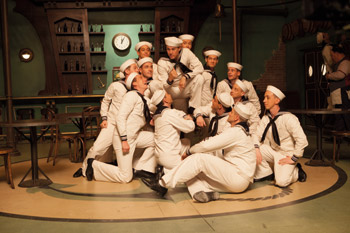 'Hobie is completely inappropriate for this film that Laurentz is making," explains two-time Oscar® nominee Ralph Fiennes, who plays the persnickety and exacting director. It's another comic turn for the Shakespearean-trained actor who garnered acclaim for his recent hit comedy, The Grand Budapest Hotel.
'Hobie is completely inappropriate for this film that Laurentz is making," explains two-time Oscar® nominee Ralph Fiennes, who plays the persnickety and exacting director. It's another comic turn for the Shakespearean-trained actor who garnered acclaim for his recent hit comedy, The Grand Budapest Hotel.
'Laurence has no choice," Ralph Fiennes continues. 'He's told to work with this young man. While Hobie is successful in his own type of film, Westerns, that doesn't necessarily mean he can or should do everything. He's a cowboy actor who's being asked to star in a drawing-room drama with people in tuxes and ball gowns, and he can't quite seem to get his mouth around the dialogue. Laurence is looking for a virtuoso ease with that sort of sophisticated flair, and Hobie can't access that. The harder Laurence tries to school him, the more nervous and intimidated Hobie becomes."
Another comical conceit is the dual role of Thora and Thessaly Thacker, identical twins who also happen to be rival gossip columnists, though they do not like to be referred to as such. Thora and Thessaly are an amalgam of the real life rivals Hedda Hopper and Louella Parsons, as well as advice columnists Abigail Van Buren and Ann Landers, who were identical twins. One of Eddie Mannix's biggest challenges is keeping inappropriate gossip away from the sisters and, at the same time, playing ball with them, bribing them each with 'exclusives."
Thora and Thessaly are both played by Oscar® winner Tilda Swinton. 'They're identical twins who like to believe the other one doesn't exist," she observes. 'Each is a thorn in the other's side. They compete for everything, from hat size to stories, and would much prefer to really be alone in the world. They're a trip."
Further complicating matters is the fact that people don't always know which of the columnists they're talking to, Thora or Thessaly. 'Eddie Mannix certainly doesn't," Swinton mentions. 'One of them has 19 million readers, the other 20 million. One has a mole here; the other has a mole there. Neither likes to be referred to as a gossip columnist, and they're not. They're -cultural commentators.'"
Tilda Swinton explains what she found most compelling about the two characters and their real-life antecedents: 'Thora and Thessaly are part of the myth-making machine that was so important back then. It was a dream world made up of humans who were not always so dreamy. At the same time as they're involved in knocking these gods and goddesses off their pedestals, they also need to build them up. Otherwise, they'll have nothing to write about. So it's this vicious circle of building up and tearing down, tearing down and building up."
New- and Old-Timers: On Set with the Coen Brothers
Eddie Mannix is not the only person to make his talent feel safe. The actors and crew members of Team Coen felt equally protected. Many are veterans of their films, but even those who were working with them for the first time enjoyed the relaxed, yet meticulously planned production in which they found themselves.
Despite the fact that, so far, they've only called on him to play doofuses, George Clooney willingly packs his bags whenever the Coen brothers reach out. He muses: 'If you look at the history of filmmaking, if you look at the greatest directors of all time, none of them were making their best films 30 years into their career. They generally made them in their early days or in the middle of their careers. But these guys are still making unbelievably great films. They will go down in the history books as among the great filmmakers."
In their own way, George Clooney continues, the Coen brothers adhere to the classic style of filmmaking they celebrate in Hail, Caesar!. 'They only shoot what they're going to use," he says. 'Part of that is because they started out as editors [Joel assisted on Sam Raimi's The Evil Dead]. On many films you get a script in October, and it won't shoot until March, and by then there are 30 pages of rewrites. But not with Joel Coen and Ethan Coen. The script you get is basically the script they shoot, and the only shots are the ones they're going to use. They've already edited the film in their head, and it's panned out."
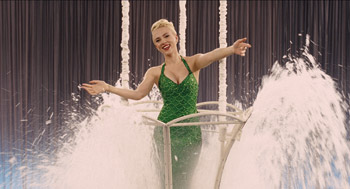 Similarly, offers Channing Tatum, the Coen brothers also had him at 'Hello." He had done comedy before, particularly the Jump Street movies, and he'd also danced in the Magic Mike films. 'But I've never done either for the likes of Joel and Ethan Coen," he enthuses. 'Being on the set with them was such an education. They're super specific; the historical accuracy was perfect. They're not only poking fun at the movie industry and its history, but also honoring it at the same time. It's quite an impressive feat."
Similarly, offers Channing Tatum, the Coen brothers also had him at 'Hello." He had done comedy before, particularly the Jump Street movies, and he'd also danced in the Magic Mike films. 'But I've never done either for the likes of Joel and Ethan Coen," he enthuses. 'Being on the set with them was such an education. They're super specific; the historical accuracy was perfect. They're not only poking fun at the movie industry and its history, but also honoring it at the same time. It's quite an impressive feat."
Channing Tatum was taken by the look and feel of how films were made back in the Golden Age. In particular, he was impressed by the painted backdrops, which are specific to this period. Though clearly artificial on set, when seen through the camera lens, they looked quite real. 'It blew my mind," he adds. 'I was able to understand how movies were made back then"from the way they were shot to the way the camera moves seamlessly from one stage to the next. It's like a dream walk through a studio lot in 1951."
Scarlett Johansson was particularly drawn to the period of this movie. 'I thought it would be fun to do a character piece based on Hollywood's golden era," she enthuses. 'What actor wouldn't? Look at the costumes, the glamour, the quality and the behind-the-scenes environment. I was sold. That, plus the Coen brothers are very playful on the set. They know what they want, but they also are open to suggestions. It was a safe and creative environment."
Josh Brolin, who has worked on several Coen brothers films, including No Country for Old Men, laughs that his main attraction to the project was the fact that he got to slap George Clooney…all day, thanks to retakes. 'Curiously, George Clooney didn't seem to mind." When they were supposed to be rehearsing the slapping scene, George Clooney was still in England and sent Joel Coen an email apologising to him and Josh Brolin. 'Just tell Josh Brolin he can slap me as hard as he wants when he sees me," the actor wrote.
'That was very professional of him," Josh Brolin continues. 'And we had a wonderful time doing the scene. George Clooney is a great guy, and he was totally game."
Eddie Mannix doesn't hit Whitlock maliciously, Josh Brolin explains. 'He gets slapped because he's having a tantrum. He wants his Froot Loops, and he can't have Froot Loops because he's had too much sugar today. So, he needs to understand the word -No.' He needs to understand he's being disrespectful. Remember what Cher said in Moonstruck when she slapped Nicolas Cage? -Snap out of it!'"
Like Channing Tatum, Ralph Fiennes is a first-timer in a Coen brothers film, though he confesses he's been waiting for the call for years. The performer says: 'Their scripts are surprising and they evolve unpredictably, both in terms of characters and plot. No one film is like the other, although if you see them all, you start to feel a particular imprint."
The experience more than lived up to his anticipation, Ralph Fiennes says. 'Joel and Ethan Coen have a low-key way of directing, very relaxed. It's a rare thing; there was a wonderful atmosphere on the set. It moved fast and a lot of work was done quickly, as opposed to a lot of other shoots. They have their team and are confident of everyone working around them. It's all very efficient."
Re-creating the Golden Age: Design of the Film
Hail, Caesar! was production designer Jess Gonchor's sixth outing with the filmmakers, starting with their Oscar® winner for Best Picture, No Country for Old Men, and including his own Oscar®-nominated work on True Grit. Even so, this film was an assignment apart. 'Making a movie about making movies is special," says Jess Gonchor, 'and I doubt that I'll ever get to do it again. I just tried to enjoy it as much as I could while we were working on it."
Jess Gonchor and his crew eagerly dove into researching the various kinds of films being shot for the movie, as well as the behind-the-scenes look at filmmaking back in the '40s and '50s. He was fortunate that, at the time, studios had a photographer on set who recorded the look of the movies. He not only had access to a rich lode of archival material but actually picked the brains of craftsmen from the era who are still alive and were quite eager to share their knowledge. 'It was so much fun to go through all those archives and retrace the steps that the production designers of the era took to achieve the look of their movies," he notes.
The various styles of the movies within Hail, Caesar! were also invaluable. 'We were constantly coming in with something we found, like, -Look at how they did this on The Robe, and look at this Roy Rogers movie.' Everybody was so into it and enjoying themselves."
In his research, Jess Gonchor was drawn to how movies were made back when, on a giant set, there was a nucleus of the director and the cinematographer and the camera crew. Of course, today the process is more spread out because of video monitors and the ability to stream footage on iPads and look at it instantaneously. In addition to building physical sets with today's moviemaking techniques, the sets can be enhanced and extended through graphics.
Another big difference was the look of the crew on set, Jess Gonchor points out. 'Now it's blue jeans and T-shirts, but in the 1950s the men wore pants and some wore suits. People smoked on the set, and the equipment was huge."
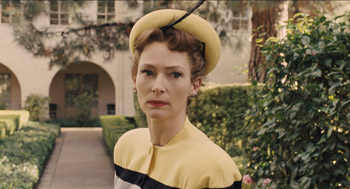 Jess Gonchor had access to period equipment, cameras, lights and grip tools for the movies being shot within Hail, Caesar! 'To be able to have cameras on sticks and silencers and blimps, it was just incredible," commends the production designer. 'The whole thing immediately became real."
Jess Gonchor had access to period equipment, cameras, lights and grip tools for the movies being shot within Hail, Caesar! 'To be able to have cameras on sticks and silencers and blimps, it was just incredible," commends the production designer. 'The whole thing immediately became real."
Working alongside 13-time Oscar®-nominated cinematographer Roger Deakins and costume designer Mary Zophres, both longtime Coen brothers veterans, Jess Gonchor and his team used color to differentiate the environment of Capitol Studios and the sets where the different movies were being shot.
'When we were in Eddie Mannix's office, the look was almost blue collar, not glamorous at, all," Jess Gonchor relays. 'Then when we moved onto the sound stages, we cranked up the color and the fantasy element. The sets were larger than life to demonstrate how we were traveling into the magical world of studio filmmaking."
One of the most gratifying surprises that Jess Gonchor experienced was late in filmmaking, after he'd already designed the Roman epic by creating sections of the Appian Way and a Roman temple. The crew came upon drawings in the UCLA archives from the early 1950s blockbuster Quo Vadis and discovered that, according to the designer, 'We were really close to what they were doing almost 70 years ago. That was a pretty cool day in the art department."
Costume designer Mary Zophres, whose work for the Coen brothers earned her an Oscar® nomination for True Grit, started researching Hail, Caesar! even before it was greenlit, based solely on a meeting with the filmmakers. 'By the time we started pre-production, I had all my sketches done and all my boards done," she says. 'For a movie like this, the task was enormous. I've never had so many boards and sketches and ideas. But thank goodness I did, because even with 12 weeks of prep, it still wasn't long enough for the film, which is more like several films in one. It was an incredible challenge, but loads of fun and a costume designer's dream."
Unlike other movies, the look of Hail, Caesar! was extremely varied. The main story had one look, and each of the films being shot on the studio lot had another, Mary Zophres explains. This entailed the use of varied palettes and costumes"from Roman tunics to mermaid outfits and from Western wear to formal wear and everyday '50s apparel.
For the primary story, Mary Zophres boned up on movies from the late 1940s. Though Hail, Caesar! takes place in 1951, she says, 'The reality of that time period was that nobody was cutting edge. No one went out and bought the latest men's suit. People usually wore what they'd been wearing for the past few years."
Since she had recently worked with Josh Brolin on the period mobster film Gangster Squad, Mary Zophres wanted to make sure he sported a distinctive look in this film. Mindful that he would be wearing the same suit throughout, she scoured costume houses until she happened on a double-breasted suit that she thought had the perfect silhouette and color"a medium-brown, which blended perfectly with Josh Brolin's skin tone. 'I was going for a specific look for Josh Brolin and told him to let his hair grow out and let the gray show. Because at the time, he was very lean, I told him to eat whatever he wanted. I wanted him to have stature on camera, and that required a kind of thickness."
The idea for giving the character a mustache came from looking at photos of studio heads during the period. The one that caught Mary Zophres' eye was Walt Disney who, she reflects, 'had a great little mustache." She also permed Josh Brolin's hair 'and when I looked at him, he seemed to have stepped right out of the period. It was magic."
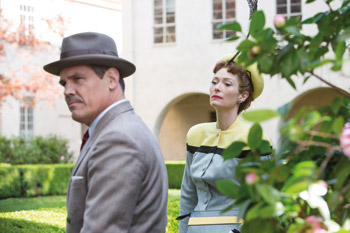 To cap it off, Josh Brolin wore a homburg, 'and not a fedora," Mary Zophres emphasizes. 'No one else in the movie wears a homburg because Josh Brolin is the lead, and we felt that would set him apart from the other characters."
To cap it off, Josh Brolin wore a homburg, 'and not a fedora," Mary Zophres emphasizes. 'No one else in the movie wears a homburg because Josh Brolin is the lead, and we felt that would set him apart from the other characters."
This kind of meticulous research and detail extended even to dressing and casting the film's extras. In all, 2,500 to 3,000 outfits were needed for the film, including about 500 that had to be custom-made, says the costumer. The extras casting director, Debbie Delisi, had a knack for handpicking faces that were period appropriate. 'Some people look very contemporary, no matter what you do. Then you have to worry about hair length and finding women who hadn't dyed their hair or had Botox, which is not easy in Los Angeles," she laughs.
Then the extras had to be dressed so as to appear authentic, and at the same time not stand out or pull focus from the main actors. All the men wore era-appropriate high-rise pants, and all the women wore 1950s-style undergarments, including those in the movies being shot on sets, according to Zophres.
'Dressing background is the best practice for a costume designer, because in my mind I have a back story for everyone, no matter who you are in the film," explains Mary Zophres. 'You want them to feel real but also to be part of the overall tableau."
Costuming Swinton was a breeze, says Mary Zophres. 'Tilda Swinton looks good in anything. This is where we went over the top a little bit, even though she's in the real movie part. But she's a larger than life character, actually two characters. Both of them wear a suit and a large hat with a feather. On one sister the feather tilts to the right, on the other sister it tilts the other way."
Channing Tatum's look was modeled on actors from the period, specifically Troy Donahue and Tyrone Power. Particularly in the nightclub sequence, which is a crucial scene for his character, Channing Tatum was dressed to stand out in a light-colored sport coat and a shirt without a tie"a look inspired by a photograph of Power. While almost everyone else, including Ehrenreich, was clad in dark formal wear. For his part, Ehrenreich had the most varied looks in the film"from plaid cowboy wear to street clothes to tuxedo.
Like Josh Brolin, many of the characters and background players in the film's main story were outfitted in dull, earth tones, which stand out from the movies that are being shot in vivid Technicolor hues. For the films within the main movie, Mary Zophres studied other notable costume designers from the period, such as Edith Head and Adrian, for a more heightened movie look.
George Clooney, says Mary Zophres, 'basically wears a dress in the movie and he likes it above the knee." She admits surprise, however. 'Who knew that George Clooney had such great legs?"
The performer's 'dress" was actually a Roman knee-length tunic with a leather-studded breastplate, and even his sandals had a specific pattern, which are reminiscent of films like Ben Hur. George Clooney's sandals had to be custom built, as did Tilda Swinton's hats and the swim caps for the synchronized-swimming sequence starring Scarlett Johansson.
In all, Mary Zophres had to outfit about 170 Roman extras, including soldiers, and an additional 120 Israelites and 40 to 50 slaves. She points out: 'That's just one of the movies within the movie."
As if that weren't enough, all the principal players and extras had to have their hair done, for which the hair designer Cydney Cornell drew inspiration from such period epics as Quo Vadis, Ben Hur and The Robe.
The swimming sequence was particularly complex since the 'mermaids" had to swim, so a certain flexibility was required, despite having tails and beading that looked like fish scales. 'Mary Zophres was very sensitive to the body and what's comfortable for each actor," explains Johansson. 'Her designs gave you room to move. The mermaid costume was very restrictive, but she made it easy to get in and out of quickly."
Singing, Dancing, Roping: Shooting Across L.A.
Scarlett Johansson prepared for her water-ballet sequence by practicing swimming with her mermaid fin on in 'a really grimy pool in Midtown Manhattan," she laughs. 'The costume was very light but the tail was buoyant, so they had to devise a way to weigh it to make sure it didn't float up behind me, which they managed after a few tries."
'Scarlett Johansson was up for anything," explains Mesha Kussman, who choreographed the swimming ballet. 'She's so dynamic. The moment she was asked to perform, she sparkled. It was very exciting to watch."
Mesha Kussman, the director of the synchronized swimming group Aqualillies, was brought on to handle a sequence that took place entirely on the surface of the water. She explains: 'Joel and Ethan Coen had a very specific vision. All the floating had to be graceful and beautiful, just like in the old movies. We agreed on 32 synchronized performers who would swim in lyrical patterns that would change, creating a kaleidoscopic illusion. Thirty two was the exact number we needed to give the feeling of an infinite number of swimmers going around in a perfect circle and still give Scarlett enough room to dive in between them."
For inspiration, Mesha Kussman studied Esther Williams' movies, for which many of the water ballet sequences were choreographed by the great Busby Berkeley. Not by accident, the sequence was shot in the water tank at Stage 30 on the Sony (then MGM) lot. Watching Williams' movies helped the filmmakers figure out where to best place the camera and how many swimmers they would need to achieve the desired effects. 'We were the first swimmers to use the pool for this purpose since the Esther Williams days," says Mesha Kussman, 'and that alone was thrilling."
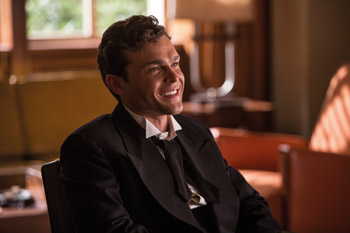 Stunt coordinator Tad Griffith was kept on his toes during the shoot, handling the Western sequences as well as aiding Mesha Kussman for the water ballet. The preparation was painstaking and meticulous, leaving nothing to chance. 'We interfaced with the various departments during prep, beginning with an emphasis on water safety for all the different crew members involved and getting the tank ready"props, set dressing, etc.," says Tad Griffth. 'Then we worked with riggers who brought in the winch systems for all the platforms, as well as with special effects and those responsible for the real on-set fountain effects. We rehearsed with stunt doubles to anticipate trouble spots so we would be prepared if problems arose."
Stunt coordinator Tad Griffith was kept on his toes during the shoot, handling the Western sequences as well as aiding Mesha Kussman for the water ballet. The preparation was painstaking and meticulous, leaving nothing to chance. 'We interfaced with the various departments during prep, beginning with an emphasis on water safety for all the different crew members involved and getting the tank ready"props, set dressing, etc.," says Tad Griffth. 'Then we worked with riggers who brought in the winch systems for all the platforms, as well as with special effects and those responsible for the real on-set fountain effects. We rehearsed with stunt doubles to anticipate trouble spots so we would be prepared if problems arose."
Tad Griffith, a third-generation stunt performer who's been working in movies since he was five years old, also helped train and supervise Ehrenreich's cowboy stunts. 'We did a lot of prep on horses," he explains. 'Alden trained for six weeks, three times a week. The first thing we did was get him relaxed on a horse and figure out at what speeds he would be comfortable."
While some of the stunt-riding tricks are performed by Tad Griffith's own son Gattlin Griffith, Ehrenreich did most of his own rope tricks and shooting. 'I'm very proud of what Alden did," says Tad Griffith, Sr. 'He really sold it. He can almost claim to be a cowboy now. He was able to learn trick riding, roping and shooting like a pro. If Wild West Shows ever come back, he's got a niche."
Ehrenreich is a bit more modest about his accomplishments. 'I wouldn't say I'm an expert roper," he states. 'But I would say that I'm a very good beginner roper. I had a teacher named Cliff Mclaughlin, whose father, Gene, was one of the best roping guys in that world and worked with Roy Rogers and Gene Autry. He showed me how to do a flat loop, and all the fundamentals of roping; that was cool to learn."
Another invaluable specialist was choreographer Christopher Gattelli, whose work on the Broadway musical Newsies won him a Tony Award, and who also received a Tony nomination for the 2008 revival of South Pacific. Creating the dancing for Tatum's big number, however, was his first movie assignment. The opportunity to pay homage to the work of such legendary screen dancers as Gene Kelly and Fred Astaire was like a dream come true.
The sequence centers around Channing Tatum's character, a dancing sailor, who is getting ready to ship out. 'Channing Tatum is very physical, a real Gene Kelly type, so I had a head start there," Christopher Gattelli offers. 'The dance is about falling in love and involves tap dancing and acrobatics for Channing Tatum and the supporting performers. Channing Tatum could dance, but he didn't do tap. He picked it up quickly though. He has this natural gift, which came in handy since he's dancing with some of the best tappers I know."
Channing Tatum also proved to be up for the challenge of the dance number's acrobatics. 'It's a jam-packed sequence," says Christopher Gattelli. 'There's also swing dancing and lifts, and Channing Tatum did headstands and flipped over the bar and then over a table. He was phenomenal. It was the perfect marriage of performer and role."
Again, Channing Tatum is a bit more modest when it comes to evaluating his accomplishments, specifically as a tap dancer. 'I knew going in that learning tap dancing wasn't going to be easy," he chuckles, 'but I didn't know it was going to be this hard. My hat's off to Chris Gattelli and [assistant choreographer] Meredith Patterson; they were extremely understanding and patient."
While admitting to a 'bit of a learning curve," Tatum used his ability to mimic movement to get started. 'The challenge was learning and remembering the choreography," he states. 'What's essential to tap is not just being able to make the sound, but to be musical. It's like playing an instrument. They shouldn't call it tap dancing; they should call it foot percussion. You're playing part of the song with your feet."
A film about Hollywood's Golden Era required the Coen brothers to shoot the entire production in and around Los Angeles. To accomplish this, they had to find iconic locations that have changed very little since the 1950s, as well as famous locales that are familiar to audiences of classic old movies.
According to location manager John Panzarella, The Lot"formerly Warner Hollywood, formerly Goldwyn Studios"in West Hollywood was the Hail, Caesar! base of operations.
Two crucial locations were decided upon early on: where the Western movie and, particularly, the Roman epic were going to be shot. 'We're in Southern California and we needed the Appian Way, which is in Italy," says John Panzarella. 'So we had to figure out where someone in Hollywood would shoot that sequence in 1950."
The filmmakers finally settled on the Big Sky Movie Ranch in Simi Valley, the location at which the TV series Little House on the Prairie had been lensed. 'We took a long dirt road and put in umbrella pines and monuments and an arch, and turned it into the Appian Way"with 200 soldiers marching up and down the road," says John Panzarella.
For the Western sequence, he chose a classic film location called Vasquez Rocks Natural Area Park. 'Countless Westerns were shot there," he notes. 'Also one of the most famous Star Trek episodes -The Arena' was shot there, and it was Bedrock for The Flintstones movie. The place has an iconic Western landscape. It was a terrific opportunity."
For the well of Jehoshaphat in the Roman epic, the cast and crew didn't have to go very far afield. The Bronson Caves are in Griffith Park in Los Angeles, and the former quarry has been used as a film location since 1919. 'The first Invasion of the Body Snatchers was shot there, as well as Batman and The Monkees," says John Panzarella.
The interior of the nightclub sequence where Hobie and Carlotta have their first date was also shot at the Hollywood Palladium, which today operates as a concert venue; the exterior was shot at the nearby Fonda Theatre. 'The Palladium opened on Halloween night 1940," says John Panzarella. The opening act was Tommy Dorsey and Frank Sinatra. Since then, everybody's played there"the Stones, Bob Dylan, the Grateful Dead, Neil Young, Tito Puente and tons of Latin bands. It hasn't changed that much from 1940, so where else would we shoot our supper-club sequence?"
For the fixer's home base, Mannix's residence was actually two houses: an exterior in Silver Lake and a nearby interior in Echo Park.
While the water tank on soundstage 30 on the Sony lot was used for the water ballet sequence, finding exteriors for the Capitol lot proved to be problematic, since most major studio lots have been updated with new buildings and other technological improvements. The only one that fit the bill was Warner Bros., says John Panzarella. 'It still retains much of its original character and looks like classic Hollywood. All we had to do was move all the cars and the equipment. The people who work there were blown away because they'd never seen the streets empty like that, the way they were back in the day."
Finally, the Capitol Pictures Productions studio was enhanced by the use of the iconic Union Station in downtown Los Angeles for certain exteriors.
Wrapping! Hail, Caesar! Concludes
For most of the actors in Hail, Caesar!, the film represents a bridge between Hollywood's Golden Era and how movies are made today, highlighting the good, the bad and everything in between.
Clooney imagines what it must have been like to be a contract player at a studio during Hollywood's heyday. He likens the long-term commitments to the ones young athletes still face to the present day. 'It's like the deal you make with the devil," he explains. 'You're excited to be offered a contract and to be under contract. At first you're overpaid, but over time you realize you're being vastly underpaid. It must have been very frustrating. It still goes on today, mainly with young athletes."
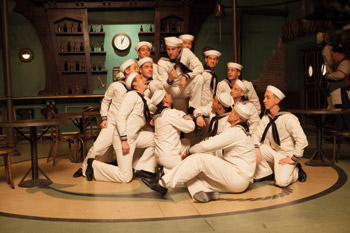 Clooney himself got a dose of that early in his career when he was under contract, though it was a much less constrained agreement and he had greater latitude to work elsewhere. 'I have some idea of what it's like to work on a lot, and know all the crew and all the soundstages. I've had a taste of that.
Clooney himself got a dose of that early in his career when he was under contract, though it was a much less constrained agreement and he had greater latitude to work elsewhere. 'I have some idea of what it's like to work on a lot, and know all the crew and all the soundstages. I've had a taste of that.
'What hasn't changed," he continues, 'is the actual physical process of making of a movie, which Hail, Caesar! celebrates. There have been some great technical improvements, but there's still a crane with a camera. Lighting it still lighting. Sound is still sound, and the director still calls the shots."
Swinton agrees with her fellow star: 'Films continue to transport all of us, even those who are lucky enough to work in them. There's something forever about them. As Eddie Mannix says about Baird Whitlock, my characters can't expose him as I am threatening to do, because he has to remain a fantasy, a dream. People needed it then, and they need it now."
In the past, studio fixers represented one of the main ways in which stars' images were cultivated and protected. 'I think they need them today, probably more than ever," says Tatum. 'Now stars have publicists and lawyers instead, because a fixer would have a hard job today. People have to watch what they do. But back in 1951, you could literally get away with murder and go to Eddie Mannix and say, -Hey I messed up man,' and he'd say, -Don't touch anything. I'm on my way.' It's a scary thought."
Though some of the problems Mannix dealt with wouldn't be terribly scandalous today, observes Brolin, they still have contemporary parallels. 'The issues are different, but there's still the National Enquirer and those kinds of things. Those reporters don't give up, because their philosophy is that every actor, filmmaker and director is lying. They think that they're never telling the truth, and if they keep at it you'll find the dirt. The problem is, at least 50 percent of the time, they're right. Even when they are wrong, though, and you confront them, they refuse to admit they're wrong."
Beneath the humor, says Fiennes, Hail, Caesar! is truly a microcosm of the entertainment business. 'It looks at the hierarchies, the vanities, the insecurities and loneliness. It looks at the dream of success and the heartbreak of failure. It shows how human vulnerabilities are exposed and magnified within the movie and theater world."
One thing that's never changed, Fiennes stresses, is the tension between the business and the art of film. 'Directors still want to imbue a film with their vision, but their artistic vision may not be viable in putting people in seats in the movie theater."
And truly, in the end, the one thing that hasn't changed and never will, according to Tatum, is that films are still all about helping an audience escape. The best part of Hail, Caesar!, he shares, 'is that the movie is wildly entertaining on any level. It's a tribute to an art form, even if some of its luster has been lost somehow along the way."
Hail, Caesar!
Release Date: February 25th, 2016
Have You Seen This?
MORE




